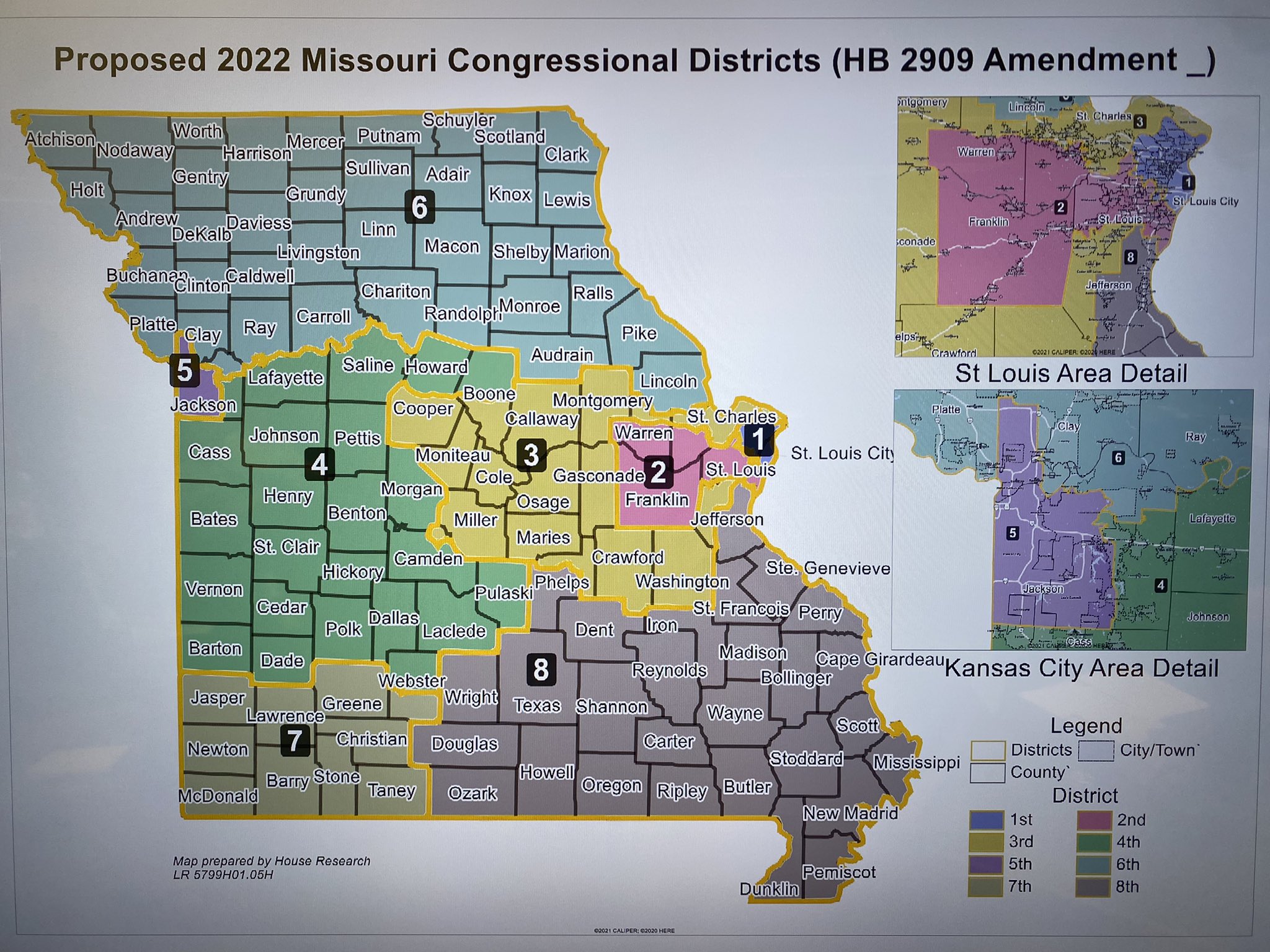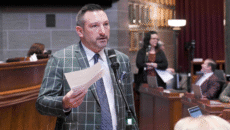Editorial Note: This is part 1 of a 3-part series on the congressional redistricting process.
On Thursday May 12, a day earlier than constitutionally mandated, the 2nd session of the 101st Missouri Congress General Assembly was brought to an end, though the Senate journal holds that May 11 was the session’s last day.
On the last day of session, many were surprised to see Sen. Bob Onder stand aside and allow the Senate to vote on Missouri’s congressional map without attempting to stall. Onder had previously led a 31-hour filibuster to slow progress on the map’s passing.
Missouri was one of the last states in the United States to finalize its congressional map. Heated debates over the splitting of St. Charles and Jefferson Counties as well as other minor alterations to the map led to significant delays.
Further impacting the delay were the effects of the COVID-19 pandemic, which caused a year-long delay in the census data that is used to create new congressional maps,
The process of redrawing the congressional map took on greater political importance this year when US Sen. Roy Blunt announced his retirement, seeing two members of Missouri’s legislature leave their seats open to seek election to the Senate.
Sen. Onder received significant criticism for attempting to draw a map that would favor him in a run for Congress. Onder centered his approach around keeping St. Charles county solely in one district.
Onder was not the only Missouri lawmaker attempting to create a district that favored him. Speaker of the House Rob Vescovo and Rep. Dan Shaul, both of whom were explicitly involved in the map-making process, wanted their native Jefferson County whole just as much as Onder wanted St. Charles County solely in the third district.
Several others including Sen. Rick Brattin, Sen. Eric Burlison and Sen. Mike Moon were actively mounting congressional campaigns while drawing the districts they would be running in.
The story behind the delay in congressional map approval and the need for a deal to pass it starts after Missouri’s 2018 election. A newly elected Senate, missing several of its previous leaders like Senators Kehoe, Richard and Wasson, met to elect new leadership.
The fallout from those leadership elections led to the formation of the Senate’s conservative caucus, and the ensuing three years of political battles fostered an element of bad blood and distrust between the factions. The rancor reached its peak over the battle of drawing congressional districts and who was going to benefit the most from them.
The Missouri Times spoke to the three Senators in the room when the final deal was cut to pass the map. Senate Majority Leader Caleb Rowden, Senate Minority Leader John Rizzo, and de facto leader of the Senate conservative caucus, Senator Bill Eigel.
Prior to Session
Normally, redistricting chairs and committees are named by the previous session’s leadership and are able to begin the process early. Former Speaker Elijah Haahr, being from Greene County — which wasn’t in danger of being split — was well placed to start the proceedings off on stable footing.
However, a mix of intra-county rivalries, intra-state Senate district jealousies, and bizarrely antisocial paranoia led House Speaker Rob Vescovo to state that if he didn’t get to name the house chair himself, he would disband Speaker Haahr’s committee when he took power and and reappoint a Jefferson Countian of his own, Rep. Dan Shaul as chair. As it turns out the House didn’t get the census data until Haahr was already out of office.
Rep. Shaul’s committee held several hearings and in the end came up with a map that was well received by most of the state’s political leadership. The exception being Onder and Eigel as St. Charles County, which both of them represent, was split nearly in half.
“People try to make this more than it was, it was a very important item. But it was still a bill that had to be negotiated, and to go through the process,” Shaul said. “Certainly, the Senate chair and I talked, I talked with several Senators along the way. And we went through the process just like we would on any other bill.”
In a scenario reminiscent of the China Hub special session and Senate gridlocks of the past, both house and Senate leadership came out with statements of support for the map. However, there were several Senators who were not consulted, and just as with China Hub they became a problem for the map’s passage.
The Senators seemed to echo comments from the past, “I was never spoken to about the map in December”, said Sen. Eigel. “I tried to call Bernskoetter, I finally went to him with a 6-2 and a 7-1, and made our proposal. Not only were none of my suggestions included in the December map, it was like he purposely took anything in that proposal and chose not to include it.”
“I can’t imagine anyone thought we would allow that map to pass without a fight,” Eigel added.
Despite insistence during the session from the St. Charles County Senators, Sen. Caleb Rowden felt as if most rural lawmakers didn’t want their counties placed in the same districts as Missouri’s major metropolitan areas.
“We talked about a 7-1 map, and it was clear then that a majority of the caucus wasn’t interested in the idea of drawing the big cities in with their rural districts,” said Rowden. “I really don’t remember any conversation at fall caucus that St. Charles had to make up a certain percentage of the third.”
Prior to the map being released, Senators Eigel and Onder attended a meeting that Speaker Vescovo requested. The purpose being for Vescovo to tell the leading members of the conservative caucus that he was “100% definitely running for state Senate.”
The Senators attempted to also discuss the congressional maps at the same meeting, bringing drafts of maps they were proposing to the meeting. However, the meeting did not go as they planned.
“He got very awkward and wouldn’t even look at our maps. He almost ran from the room and kept saying, ‘we’re not near nut cutting time’— it was bizarre,” Eigel said of Vescovo’s behavior.
After the first map was released in December, the St. Charles County Senators requested a meeting with Rep. Shaul where they expressed their frustrations with the initial map.
“We told Shaul we wanted a 7-1 map, but he said no to that,” Eigel said. “So instead we asked him to consider a 6-2 map that strengthened the 2nd Congressional and didn’t break up communities of interest, including ours in St Charles.”
According to Eigel, Shaul made a bad situation worse by promising to not break up St. Charles County and going back on it later.
“He said he would do that, but that commitment lasted roughly as long as the end of the meeting. Certainly, this was one of the building blocks of the tension leading into session,” Eigel said.
From Shaul’s perspective, he wasn’t asked to consider anything, instead he was being told what to do.
“I was invited by the two Senators there to sit down and talk before session started … It was an interesting meeting. I was really just lectured, not really spoken to. I mean, it wasn’t really a conversation, it was more I was told what I was going to do,” Shaul said.
“They made several demands of me, and I told them, I would see what we could do to try to make a map that would represent the state of Missouri,” he added
Eigel and Onder both had their doubts about the amount of influence Shaul had on the map. Both felt as though the house was giving in to private interests in the legislature as many politicians haggled to get districts that benefitted them.
“At first, both Bob and I were upset with Shaul’s apparent lack of integrity. But, looking back, the problem was that he was never in charge of anything and had no control.” Eigel said.
“That entire house map was produced by Vescovo and some consultants working to get Blaine Luetkemeyer the map he wanted — He was a chairman in name only, it meant nothing.” he added.
In Rowden’s view, bringing in extra consultants was a political and common-sense decision, not yielding to the interests of a few lawmakers.
“We knew in December this would be a fight. Holding Senate hearings would have made absolutely no difference, we just chose not to give them more leverage earlier,” Rowden said.
“Onder kept saying that we shouldn’t care what people like Ann and Blaine think. In reality he just tried to vilify anyone that wasn’t him because he was the only one who had that opinion.”
Rowden felt the entire pre-session consultation was an overblown situation, as the end result was going to stay the same either way.
“This was never gonna be a four people in a room decision, it was always gonna be an entire Senate conversation,” said Rowden. “Everyone was ultimately going to have a say and it was always going to be a challenge, regardless of the process.”
Maps During Session
The house went straight to work on the map. Rep. Shaul’s committee heard a very impassioned plea from Ray County not to be split, and ultimately they were made whole as there wasn’t a Senator or influential representative that viewed Ray County as key to their political ambitions.
On the floor, Rep. Nick Schroer of St. Charles County made a 7-1 map proposal that could have gained traction. While his amendment was on the floor, Speaker Vescovo decided that he wanted the amendment pulled.
Schroer refused to withdraw his amendment, despite being pressured to do so by house leadership for over 20 minutes. When there was concern his map would garner significant support on the floor, Vescovo ruled it out of order. The house then went to another map to the surprise of its sponsor Rep. Ron Hicks, that 7-1 map was soundly defeated on the floor.
“The Conservative Caucus worked with Nick Schroer to develop the 7-1 map that he brought to the House floor—it not only increased the number of people from St Charles County into the third, but included several fixes the conservative caucus was looking for and it was the 7-1 map that the Republican public was looking for.” Eigel said.
“Once we realized Shaul was irrelevant there was no reason not to try a different route. When that 7-1 map gained traction, Vescovo killed it. The fix was clearly in for not getting a 7-1 map,” he added.
The house ultimately passed Rep. Shaul’s map overwhelmingly.
Check back tomorrow at missouritimes.com for the second of this three part series.












